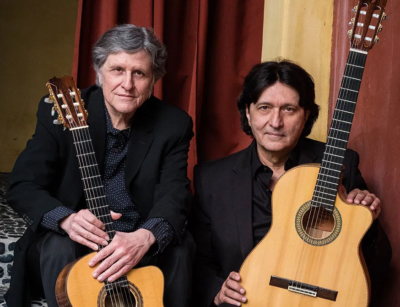 Here’s a real blast from the past I uncovered the other day while perusing some old StringDancer backup folders in a dusty old hard-drive.
Here’s a real blast from the past I uncovered the other day while perusing some old StringDancer backup folders in a dusty old hard-drive.
BACKSTORY: It was 1998 and (unbeknownst to me) I was approaching the end of my decade living in Bakersfield, California. I had been online a few years at this point, and had risen to the position of Assistant Forum Leader for America Online, then the undisputed king of pathetically slow 28k CD-ROM dialup internet access and nascent content delivery. I had voluntarily whored myself out to AOL (in return for a free account) under the auspices of the Music & Sound Forum, which was the umbrella group for all things music. I eventually became their go-to geek in charge of updating all the various channels in the forum whenever a design change was spit out by the gainfully-employed head designers, an event that would happen every few months. Between updates, I worked in creating content for a select few channels that interested me. What a deal.
But prior to generously assuming all that responsibility for no money, I had started my tenure at AOL as a lowly garden variety community leader in charge of GTR (keyword: guitar). I inherited the gig from one of the the original creators of GTR, a music buff named Keith (eventually metamorphosing into a Kate) who could no longer keep up with the grueling chores of channel design updates, being legally blind and all (long story).
At the time I was listening to a lot of Strunz & Farah, the nylon-string guitar duo who were dominating the alternative LA airwaves in those days with their incendiary Flamenco/Jazz stylings. I don’t recall exactly how it came about, but I somehow came across their contact info, and since they were based just a stone’s throw down the 5 in LA, I gave them a call, introduced myself as the head honcho for GTR, and asked them if they would grant me an interview. To my surprise, they accepted!
I took a tape recorder with me (along with my Turner Renaissance nylon-string MIDI guitar rig), and what follows is the transcript of that most interesting day in June of 1998. Originally posted in GTR, after “the schism” (long story) it would eventually be one of the first articles I published in StringDancer.com, way back in its initial incarnation as an independent online guitar community. For whatever reason, through a variety of subsequent revisions in StringDancer’s focus, the article fell to the wayside. Perhaps I felt it had become too dated to be of much interest to anyone… I don’t know, I’ve slept since then.
However, having newly rediscovered the piece, and despite it being decades out of date, I figured this old gem should nevertheless, and once again, be archived in StringDancer, just for old times sake.
Hope you enjoy. ~~JF


Somewhere in the outskirts of Los Angeles…
On a mild and sunny spring day we found ourselves driving along narrow, winding streets, bordered by the exquisite down-homes of affluent Los Angeles movers and shakers still possessed of a love for the earthy. It had been a tough winter in LA, yet here the trees and flowers luxuriated in soil lubricated with the sweet, abundant waters of El Nino. Familiar music danced in the speakers as we turned finally onto a dead-end road, the traffic dwindling to only a child on her bike. We were looking for a home “that looked as if it had been dropped out of a fairy-tale”, according to the directions given us.
There was no mistaking, then, the large, 1930’s converted horse stable nestled comfortably in the woods for anything other than the home of Jorge Strunz and wife Kathlyn Powell — a beautifully gabled and stain-glassed edifice also functioning as the recording studio of one of today’s most fiery and prolific guitar duos, Strunz & Farah!
StringDancer photographer, Romana13, and I were met at the heavy oak door by the gentle, warm, and gracious personage of Kathlyn Powell. As we were escorted to a thick leather couch, warm cups of tea appeared, and we were left for a moment to admire the hand-hewn chairs, the beautiful art scattered thoughtfully about the room, and the lofty, serene space about the fireplace.
Simultaneously, there was a grand entrance by the two guitarists we had come to interview. Ardeshir Farah quietly slipped into view from one end, as Jorge Strunz appeared, descending the spiral staircase gracing the opposite end of the great room. Handshakes, greetings, seats, pleasantries, turning on the tape recorder — and we were off and running.
We talked leisurely about our obvious favorite topic, as well as the recent litigation with their former record label (Strunz – “They owed us over $500,000 in back royalties. We just settled last week … so we’re still decompressing from three and a half years of *major* legal bills and battles”). In a long, rambling interview, we covered guitar and composing techniques, Latin American music, flamenco, radio programming practices, and their soon-to-be released album. Throw in a few road stories, some laughs, and a little honey in the tea, and you have the makings for a great afternoon.
They kindly gave us a tour of their studio facility (a well-architected recording environment included in the house, which they bought about a year and a half ago). Supertramp recorded their last album here, and no less a legend than Tina Turner has cranked out some tracks within these paneled walls, as well.
True guitar buffs, they each brought forth their beautiful flamenco guitars for me to play. Their old standby road axes, their favorite studio instruments, and some brand new, custom models, all graciously laid before me to try. In the interest of reciprocity, I hauled in my Turner Renaissance MIDI-Classic, plugged in my pedal board, and leaned back smiling in delight as these two men, each a totally outstanding guitarist, took turns test-driving my Turner.
{Following this interview is more info on their guitar rigs and studio hardware}
Jorge (the more outspoken of the two) possesses a quick mind, a subtle wit, and an astute grasp of the music business and of their band’s significant niche in the marketplace. Ardeshir speaks quietly, serenely, with just a trace of a rich, Persian accent, and his eyes radiate the warmth of his personality.
As the two men talked for the interview, they often glanced at one another, as if forming their thoughts together before either of them spoke. The symbiotic coexistence of two such talented musicians bespoke the untold hours of working, dreaming, and achieving which they have shared over almost twenty years of playing together.
From the Official S&F Bio:
Jorge Strunz Oreamuno was born of an old family in Costa Rica. His father, a diplomat, was often on the move, so he was raised also in Colombia, Mexico, Spain, England, Canada, and the United States. Jorge received his first guitar at the age of six from his uncle, but began studying in deep earnest at the age of 11, focusing his autodidactic obsession on flamenco guitar techniques and repertoire. As a teenager, he worked as a professional flamenco guitarist accompanying Spanish singers and dancers and as a soloist. He later also explored and performed other styles of guitar, such as folk, blues, and jazz, but the Latin and Caribbean music of his childhood milieu echoed in his soul, calling him back. He then formed the Latin jazz ensemble Caldera and recorded 4 albums for Capitol. After this, he returned exclusively to his first love, the acoustic guitar, and searched for a partner for a guitar duo.
Ardeshir Farah grew up in a beautiful, old Persian house in which reverberated with the violin of his uncle, a performer with the Teheran Symphony. He began to teach himself to play the guitar at 11 years old, and was soon so sought after as a popular musician that his family sent him off to school in England in an attempt to dissuade him from the profession. But the guitar was too deep a passion, and he continued to play even while getting a degree in architecture in the United States, after which he hurled himself once more entirely into music. He has performed with many of Iran’s top artists who were uprooted from their homeland by the revolution.
In 1979, Jorge and Ardeshir met in Los Angeles, and within hours were playing formidable works such as Monti’s Czardas in harmony at blazing speed. They prepared a repertoire, began performing together, and soon thereafter recorded Mosaico (1980), their first project as Strunz & Farah. Due to lack of record label interest (“great stuff, guys, but where are we going to sell it, Timbuktu?”), they originally put this recording out themselves. An enthusiastic reception by radio and the public brought Strunz & Farah to the attention of Fantasy/Milestone, with whom they put out two critically-acclaimed recordings, Frontera (1984) and Guitarras (1985). They then put out an intimate direct-to-two-track audiophile recording with Waterlily Acoustics/AudioQuest entitled Misterio (1989). Following this came the very well-received recordings Primal Magic (1990) and Americas (1992). In Heat of the Sun, we savor the harvest of 15 years of close, harmonious collaboration between two of the world’s finest guitarists.
We join Jorge Strunz and Ardeshir Farah near the middle of the first cup of tea….
The Strunz & Farah Interview
Touring
You guys probably tour nonstop, no?
Strunz – “We *used* to. We did that in ’91, ’92, ’93. Mostly the States and Canada. We’re based here [in the LA area], so this is where we have our network and our contacts. Latin America as a secondary market is good for us — it’s close and there’s a lot of cultural interest in Latin American countries. Mexico, Costa Rica (my home country), Puerto Rico a number of times where our music is very popular. We’ve played Peru and Ecuador as well.”
Farah – “We also have offices in Panama.”
Ever get over to Spain?
Strunz – “Never to Spain, no. That’s like selling ice to the Eskimos, in a way. A *lot* of great guitar players in Spain! Not the same thing we do, though obviously we have flamenco influences. Traditional flamenco guitar is a very, very advanced guitar form, very intricate, very … rhythmically and technically demanding. And now that Paco de Lucia has set the standards [cuts the air above his head with his hands], all the younger players have to deal with that, and they’re all just … young lions! So, luckily, we don’t do traditional flamenco, we do a different thing.
“We’ve recently done a collaboration with flamenco guitarist Gerardo Nuñez. And that was the first time we’ve actually interconnected with the real flamenco world there in Spain. But they like our music because of the Middle Eastern and Latin American element, and we also have the jazz and improvisation which is of great interest to them over there. They’ve been open to our music which is very gratifying to us.”
Technique
You play rhythm with an open flamenco hand, as I listen to your CDs, but play your melodic passages with picks, is that right?
Strunz – “The rhythm stuff is all hand, and I play those parts. Ardeshir is strictly plectrum. I used to study flamenco when I was a kid, and so I learned the fundamental techniques. I also play some classical guitar, just to pass the time, so [the rhythm parts] is a nailed hand, yes. We take advantage of both colorations, because the combination is very nice to have, actually. And then for the melodic stuff, the really fast passages, the improvisations, we both use picks.”
Farah – “Jorge also plays some melodic things with just fingers, as well, for the tonal variation.”
Both of you are just blazing when it comes to the execution of fast, intricate passages. Any speed tips for us?
Strunz – “Metronome studies — you need to have a universal grid, a universal plot … universal ears, in a sense. If you can play correctly to ‘the clock’, then that means that nobody is going to have a problem with the interpretation of your time. It’s universal [taps foot] …. steady meter. Your timing has to be correct in any meter. It’s not just a matter of playing as fast as you can on *any* tune … each tune calls for a certain *type* of speed.
“You see that a lot — people trying to study fast stuff, and just trying to go as fast as they can, no matter what the tempo of the tune is, you know! That’s like jamming God knows how many notes into the bar, when you should only be doing four or eight, or six, depending on whether you’re doing duple or triple time. It’s simple math, and it does become intuitive after awhile.
“The idea, whether you’re playing four or six or eight, is to end on the downbeat. You can end on an upbeat, of course, for artistic reasons, but it’s best to do this only after you have mastered ending on the downbeat — to get a complete sense of the phrasing.”
I hear you using the Harmonic Minor scale, and the Hungarian Gypsy Minor scale a good deal in your music. Any other particularly interesting scales with which you’ve been working?
Farah – “Well, we have the ‘Synopticon’….”
Strunz – “That’s a book which Kathlyn and I wrote with our friend John Fowler … a computer-generated book listing all possible scales in the twelve-tone system, from the 5-note to the 9-note scales, with every chord found in them as a cross-reference. It drops off after 9-note scales, because by then you’re getting into a good deal of chromatics, anyway, and analyzing that becomes less useful.”
And it extrapolates all the modes for all the scales as well?
Strunz – “Exactly. We’ve used the ‘Synopticon’ as a reference point for specific chords, like, ‘I wonder how many different scales will fit this chord?’ Of course there are a lot of 7 and 8-note scales. The 6’s are interesting, as well as the pentatonics, because of the wide intervalic leaps, which add a lot of color.
“And there are a lot of different names for these scales, which can be somewhat confusing, so we just devised a simple numbering system to identify them. In the back of the book are some cultural notes regarding the origins of many of the scales. It’s a big scary book, but think of it as a dictionary — not something you sit and read cover to cover.
“When we play, we use all those things — Hungarian Minor, Melodic Minor, Harmonic Minor … and then you can use chromatics whenever you want, whenever it’s convenient, to make it more interesting, to make a passage easier. There are many reasons, not only musical … sometimes it’s a practical decision to help reach a different part of the fingerboard smoothly.”
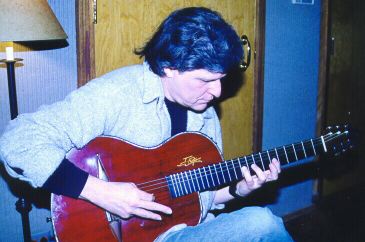
Composing
I notice most of your tunes are written by either one or the other of you.
Strunz – “Composing is really a quiet-time activity. We each schedule a time every day to compose … to sit and play, listen, look for ideas, research them, develop them into songs. When we get together, our work is then harmonizing them, arranging them (like, this part’s good, that part’s really a bridge, or an intro to this, or ‘that’s a great coda’, and so forth).”
Now at this point it’s still just the two of you, without the band?
Farah – “Just the two of us, yes. It’s a lot of work, actually, a lot of arranging, working on developing the harmonies for the melodic lines, bringing the two guitars together so they work as one.”
Strunz – “And selecting material! Like for this next album I had about 212 ideas, which I presented to Ardeshir and Kathlyn, who both help to keep me on the right path [laughter], and we then had, I don’t know … fifty ideas that *everybody’s* in accordance with. I don’t always agree with them [laughter], but then out of those fifty we select twenty, and then we’ll start work on those twenty. Then … by just time constraints and by natural preferences on how much time we’re spending on particular tunes … (it may not be that we *like* a tune better, but that it’s easier to play, or more practical to play, whatever) … we select the ten or eleven tunes that will actually be on the record.
“Then we keep in mind (since it’s all guitar, all the way through, and we don’t want to kill the listener with, ‘oh my God, this is only for guitar players!’), that there has to be a variety of tempos, keys, and within what we *do*, as broad a range of material as possible.”
That’s the beauty of Latin music — there are so many great grooves, and so many ways to weave these things together….
Strunz – “That’s true. It’s rhythmically rich. So much to choose from. We make sure we have all the tempos. The one thing we always seem to not quite get is a slow tune [laughter], we somehow forget….”
You know, I had a question about that! [laughter] I remember when the Trio’s live album came out [John McLaughlin, Al di Meola, and Paco de Lucia / “Friday Night in San Francisco“], everyone was just *floored*, but I recall thinking — the only thing I don’t like about it is that every tune seems to be a race to the finish. I just wished they would slow down ….
Strunz – “Well, that was ‘the event’! There was too much energy! You put those three guys together, and the energy goes up *so* hard that it’s hard to put the brakes on them at that point.”
Farah – “The three of them originally got together expressly to do that gig. Had they put out a third album, a studio album, I think they would have relaxed a great deal more.”
Strunz – “Yes, their second album [Passion, Grace, and Fire] was a studio album, and more under control. But the live album was just *ballistic*. I guess some of our albums suffer from the same problem [laughter].”
Radio Play
Now, you hear your music on the WAVE [LA’s innovative new-agey jazz radio station] a lot, don’t you?
Strunz – “You used to. Not so much anymore. The WAVE is now what they’re calling ‘smooth jazz’, and it’s not as diverse as it used to be. Where before they had a lot more exotic stuff, like what Arde and I represent, now they’re a lot more rigorous about … well, it has to be ‘jazzy’ sounding, which I think is regrettable because it doesn’t really reflect the diversity of a city such as Los Angeles.
“Part of the reason for this is that there’s this consulting firm in New Jersey, to whom a lot of these stations are farming out their programming, and for some reason those folks seem to think that this is the ‘correct sound’. Now what does New Jersey know about California? They’re two different worlds, in a way. Their programming doesn’t represent what’s going on here musically, and so forth. It’s oriented towards the yuppie workplace, and currently ‘smooth jazz’ is the thing. But I think the pendulum will swing back — there are already some indications that it has started to already.
“These consulting firms go out to malls with their little counter machines, and they ask people, well, what do you like listening to? And based on the information they get, they select their programming. Of course, they never tell you where these malls are located, who goes there, any real demographic information….”
Please let me know where these malls are located, so I can avoid going there! [laughter]
Strunz – “Well, it’s that our music is about diversity, you see. I feel our guitar playing contributes something to the American music scene because it *is* different. We don’t try to sound like jazz guitar players or blues guitar players, because that’s already being done very well by people who know it better than we do. We figure we can contribute to the color and variety of American music by doing what *we* know best. It’s like restaurants — you may not *want* to go to McDonald’s all the time, you might want to try a nice Indian restaurant or a Mexican restaurant — it’s culturally enriching!
“The problem with these consulting firms, then, is that they are not aware of all the demographs, because the U.S. *is* so culturally diverse. Sometimes they focus on this one area, and meanwhile this other demograph has just *grown*, and is not getting serviced. American music is really a much larger thing than we think at this point. It’s not just blues, rock, and country. The nation has diversified a lot, and there’s a lot of music out there which reflects that, and contributes to the color and diversity of the American music scene.
“I mean, the Latin population will become the nation’s largest minority in the next 4-5 years, but you don’t *really* hear a distinct Latin strain in popular music yet. But it’s bound to happen. And what a beautiful strain it is!”
It’ll be good to see the doors finally open…
Strunz – “It’ll be *great* to hear what kind of music finally evolves from there! And it’ll become ‘American music’, and people won’t think they have to be of a particular culture to enjoy it.”
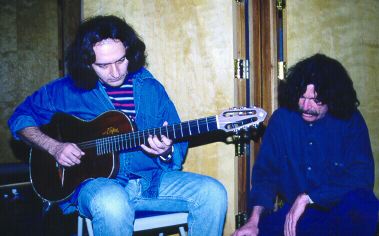
The New Album
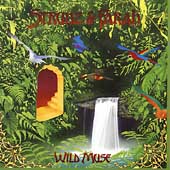 Tell us about your upcoming CD.
Tell us about your upcoming CD.
Strunz -“We’re hoping for release around late August-early September. We *should* be able to make it this time, since it’s our own label (Selva). The name of the record is gonna be ‘Wild Muse’, (we’re thinking whether it’s gonna be English or Spanish — in Spanish it’s ‘Musa Brava’). Kathlyn is working on the cover art now…”
I noticed that. She’s like your fifth Beatle, right?
Strunz – “My wife, Kathlyn Powell, is our hidden big gun, yes. She co-produces the recordings, contributes to composition, creates all the cover art, engineers, and runs a house and the office! I mean, Strunz and Farah would not be the same without Powell!
“The reason we’re calling it ‘Wild Muse’ is because on this particular record, the music is slightly more eclectic. I mean, the ‘muse’ takes us to a lot of different places here. For example there are two very Middle Eastern kinds of tunes, one in 6/8, one in 4/4, — kind of an Egyptian sort of rhythm. Then there’s the song we’re working on now, which is basically a salsa piece, with a horn section, arranged by our bass player from Puerto Rico, which I co-authored with him. We’re going for that full-on classic salsa sound. Another piece in 6/8…”
Farah – “Which is just two guitars, very spare…”
Strunz – “We may just add a bit of percussion.”
You haven’t done just two guitars very much, have you?
Strunz – “Not very often, no. And people have asked us to….”
Farah – “They say, ‘play something just the two of you — something more intimate’.”
Strunz – “We *used* to do that a lot, and then we got caught up in the band, and we kind of forgot that we used to do that!”
It almost sounds like a spiritual practice — you come in, you center, work, and “do the thing”….
Strunz – “Well, especially now, with the recording, it’s been a daily ritual. It’s been a great blessing to have *this* place, where we have our own studio, and we can work at a much more relaxed pace, and polish everything to the degree that *we* want to polish it. We engineer ourselves — after almost twenty years of recording, we have learned how to get a good guitar sound. When I play, Arde engineers, and vice versa, and nobody understands better than we do what it is we’re going for.
“Now, we’re not quite geared up for drums yet, so we still use a studio when we have full traps to record….”
Cut the basic tracks in a big studio, and bring them home?
Strunz – “Exactly, bring them home and do all the overdubs here. We have state-of-the-art digital sound here, and with the more relaxed pace, we hope this new record will have more of a *personalized* feel to it.”
The Partnership
You guys obviously get along really well. I mean, after almost twenty years of playing together, and still going strong — what a wonderful partnership! Is this dumb luck, or is there something else?
Strunz – “We have both had a realistic assessment of what we wanted our work to do. We both love the guitar, obviously, and we both knew we were gonna be guitar players. We’re both from the third world, and we came to the States, both of us having been here a long time. We both knew we could have had separate careers, both of us are good enough to do that, but we figured … we wanted to give folks a little something extra. I mean, we’re not *from* here, so our initial idea was, hey, let’s give ’em two for the price of one! We had to work harder … we’re immigrants, in a sense, so we gotta give ’em more! [laughter]
“Fortunately, the public responded very well to the *detailing*, the amount of work we put into polishing the music, and there’s two of us doing it, two different cultural influences to it … and here we are based in LA, so it makes for an more interesting ‘gestalt’ for people to see and enjoy beyond just the guitar playing.
“What we do is kind of a conglomerate, a mixture of elements — it’s got the Afro-Latin influence, the Middle Eastern influence; it’s got the flamenco, it’s got the jazz, the sense of freedom and improvisation which we borrowed from the jazz aesthetic, although we don’t use the jazz vocabulary, in the sense that we don’t play, like, bebop lines. But the concept of freely improvising without necessarily *thinking* about it beforehand, is an important focus.”
Is this the case even as the tune develops on tour?
Farah – “In some cases, if we happen to really like what happened on the record…”
Strunz – “It becomes like a musical theme…”
Farah – “And then sometimes we just say [slaps hands together], see you later!”
A Glance at Strunz & Farah’s Gear
Jorge Strunz & Ardeshir Farah play guitars made by three prominent flamenco luthiers: Pedro Maldonado (Malaga), Sobrinos de Esteso (Madrid), and Kenny Hill (Santa Cruz). They are currently using McClish hexaphonic piezo pickups in their road axes, which affords them the ability to individually adjust the output of each string, thus balancing them in relation to the intensity of the band. They are expecting to augment the piezo systems with internal condenser microphones (to get more “guitar resonance” in the mix) for upcoming post-release gigs.
We talked a good deal about the difficulties in amplifying nylon-string guitars:
Strunz – “It’s still a struggle to get them amplified properly. The state-of-the-art is still so… I mean the sound of piezo pickups is not very pleasant when compared to the natural sound of the guitars. We get a *presentable* sound when we play live, because the EQs are right, we’ve balanced the output of each string, etc. But still, sometimes it’s ten rounds onstage — the monitors are blaring, and it’s a very harsh sound. It’s sometimes a struggle to get through the set.”
Since the core of their sound is the natural beauty of two flamenco guitars being well-played together, their road effects are minimal: good EQ and a little reverb/delay. An experienced producer (and thoroughly familiar with their audio needs), Kathlyn Powell runs the front-of-house mixer.
In their beautifully designed home studio, Strunz & Farah currently use a rack full of ADATs, a Mackie 8-buss console, Lexicon effects, and Alesis monitors. Their mics of choice include an Earthworks C30X cardioid and a Sony ECM33P, among others.
The studio is a work in progress: a drum booth is being constructed, and mics and other hardware are being assembled for recording all the drums and percussion so prominent in the Strunz and Farah sound.
Musicians appearing on “Wild Muse”:
Jorge Strunz & Ardeshir Farah
Gerardo Nuñez (flamenco guitar, from Spain)
Danny Papakalos (from Greece, bouzouki)
Carlos del Puerto (from Cuba, bass, acoustic and electric)
Eliseo Borrero (from Puerto Rico, electric bass, vocals)
Charlie Bisharat (from U.S., violin)
Nenge Hernandez (from Cuba, percussion)
Cassio Duarte (from Brazil, percussion)
Luis Conte (from Cuba, percussion)
Papo Rodriguez (from Puerto Rico, percussion)
Ramón Yslas (from U.S., percussion)
Paul Tchounga (from Cameroon, Africa, drums)
Walfredo Reyes (from Cuba, drums)
Majiid Ghorbani (from Iran, zarb, darbukkha, and other Middle Eastern percussion)
Ramón Flores (from Mexico, trumpet)
Eric Jorgensen (from U.S., trombone)
Freddie Ravel (from U.S., keyboards)
Alberto Salas (from U.S., keyboards)
Interview recorded in June 1998
Copyright 1998 Jeff Foster. All Rights Reserved.
This article may not be reprinted, copied, or otherwise duplicated,
in whole or in part, by any means, without written permission from the author.
Photos by Zorka Saleeby.
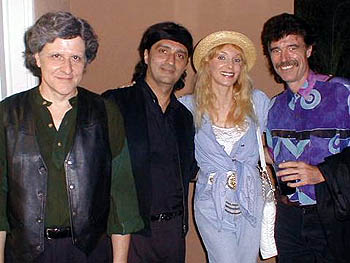
l-r: Jorge Strunz, Ardeshir Farah,
Liona Boyd, Jeff Foster
Strunz & Farah’s Official YouTube Channel



